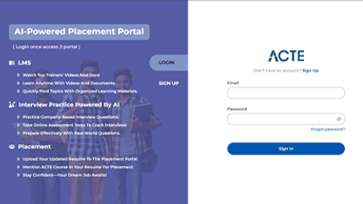ACTE's Graphic Design online course offers comprehensive training in the principles, tools, and techniques of graphic design. It will provide students with the necessary skills to become proficient in graphic design principles such as color, composition, type, vector graphics, layout, and branding. This course will also teach students how to use the Adobe Creative Suite, including Photoshop, Illustrator, InDesign, and Acrobat. In addition to the technical skills, this course will also provide students with the creative and conceptual skills necessary to excel in the field of graphic design. Students will learn how to develop ideas, create effective visuals, and produce professional level projects. Upon successful completion of the course, students will have the skills and knowledge to design logos, posters, websites, and other graphics for print and digital media.
Additional Info
Why Graphic Design Online Course from ACTE?
ACTE’s Graphic Design Online Course is the perfect way to master the basics of graphic design in a convenient and comprehensive manner. This course is designed to help you understand the core concepts of graphic design, including typography, color, layout and composition, branding, and more. You will also gain a comprehensive overview of the industry, along with the skills and techniques you need to become a professional designer. With ACTE’s help, you can learn the essential principles of this exciting field, and develop the skills you need to succeed in the world of graphic design. Graphic design is a powerful tool to create stunning visuals that help to communicate with your audience. It is an essential skill for anyone in the creative or marketing field to have. With the rise of digital technology, it has become easier to learn graphic design online.
What are the prerequisites for the Graphic Design online course?
The prerequisites for a graphic design online course typically include the following:
- Basic computer skills - you should be comfortable navigating the internet, downloading software, and managing files on a computer.
- Access to software - you should have access to software that is necessary for graphic design, such as Adobe Photoshop, InDesign, and Illustrator.
- Understanding of design principles - you should have an understanding of design principles, such as typography, color theory, and composition.
- Patience and creativity - graphic design is a creative process, so you should have the patience to explore different ideas and the creativity to come up with unique solutions.
Seven Basic Elements of Graphic Design
The seven fundamental graphic design components are line, form, color, texture, type, and image. Each has its own advantages and disadvantages. Mastering these fundamental aspects will elevate your graphic design portfolio.
1. Line: It are always more than a series of connected points. Depending on their shape, weight, length, and context, lines may be used to organize information, define forms, indicate motion, and communicate emotions. When it comes to picking lines for projects, designers have several alternatives. Lines can: be horizontal, vertical, or diagonal; be straight, curved, or freeform; be horizontal, vertical, or diagonal; be straight, curved, or freeform. The invisible lines in print design grids serve as guidelines, providing projects with greater structure and direction. In the final work of a designer, visible lines with weight and shape may transmit a range of meanings and emotions.
2. Shape: There are both two-dimensional and three-dimensional geometric shapes. They consist of a collection of dots connected by straight or curved lines and are often abstract and basic.
Humans often associate rounded edges and rings with optimism, community, love, and friendship. Squares and rectangles may symbolise equilibrium, reliability, and power. In addition, triangles have connotations with science, religion, history, civilization, and power. By selecting a certain collection of forms, you may portray stability, reliability, and order. Pick others and you will express chaos, creativity, and pleasure.
3. Color: Color may be an effective means of conveying a mood or eliciting an emotional reaction from your audience. Color theory and the colour wheel offer graphic designers with a practical framework for choosing a single hue or combining numerous colours harmoniously or purposely discordantly.In graphic design, some colour classifications are established. Primary colours (red, yellow, and blue) are the primary pigment colours from which all other colours are derived. There is no method to create red, yellow, or blue from any other hue. But, when combined, they generate a variety of hues. Orange, violet, and green are the direct outcomes of combining two fundamental colours: red and yellow produce orange, blue and red produce purple, and yellow and blue produce green. Red-orange, yellow-orange, yellow-green, blue-green, blue-violet, and red-violet are the six tertiary hues created by combining a primary and secondary colour.
4. Texture: It is the surface's feel, which might be hairy, smooth, rough, soft, sticky, or shiny. The majority of graphic designers must visually portray texture by using optical illusions to represent how their work would feel if the audience could touch it. Mastering texture is essential for creating polished, expert-looking graphics. There are several methods to explore with texture in design projects. If you are inspired by nature, you may like to work with organic textures such as leaves, tree bark, stones, fur, flowers, grass, and dirt.
5. Type: Whether you are selecting a typeface or designing your own typography for a graphic design project, you must ensure that the type is readable and suitable for the topic. Consider if your letters should be print or script, and whether their angles should be harsh or rounded, since type impacts the entire atmosphere of a design. The weight of your typography is an essential element of any design. Generally, huge or thick letters indicate the significance of the words they express. Yet, if you are not cautious, they might seem heavy-handed and disturb the equilibrium of a design. Thin letters may convey modernism or beauty, but they can also seem frail. There may be flexibility in the final design of your logo to add more than one typeface or size if you cannot decide. As a general guideline, though, you should not exceed three in a particular project.
6. Space: Spacing is an essential tool for every designer. It may provide a design breathing space, boost its visual impact, counterbalance heavier visual components, and highlight pictures or statements that the audience should remember. A design that lacks sufficient white space risks becoming too visually busy for the target audience to comprehend. Spacing may either divide or connect items. Tight spacing between graphic components indicates a strong association, while larger spacing indicates a weaker relationship. When you surround a visual piece with space, you emphasise its significance, but the space may also convey feelings of loneliness and isolation.
7. Image: Whether using pictures or drawings, graphic designers depend on visuals to capture the audience's attention and convey certain ideas. It offers context for the designer's message, adds required drama or action, and establishes an overall atmosphere. It is essential, when using photos into your writing, to choose an image that conveys the appropriate narrative and optimises visual appeal. You may choose a picture with many contrasting colours and textures, which would be a visual feast for the audience and keep them engaged. Alternatively you may highlight a certain portion of a picture to indicate where they concentrate their attention.
What Are The Advantages of Graphic Design ?
- Constant and distinguishable branding : Having a Graphic Designer produce or choose the appropriate logos, photos, graphics, or layout for your creative materials can provide visual consistency for your organisation across all of the channels it utilises to communicate with customers. Consider the role that graphic design plays in the branding and any forward-thinking design decisions of any successful organisation.
- Visual communication: Beyond building your brand, graphic design is a crucial tool for communicating with your target audience. A picture or text alone cannot express all that excellent graphics can, hence it is the responsibility of a Graphic Designer to provide emotionally engaging creative materials.
- Increase sales and competitiveness: Excellent graphic design will increase a company's visibility in the marketplace, leading to an increase in revenue. Considering the connection between intelligent graphic design and considerations such as usability and user experience, there is enough evidence that graphic design alone has a significant impact on consumer behaviour.
Where are the Graphic Design Courses?
1. Visual communicators are graphic designers: Using a combination of visuals, words, and pictures, they enlighten and fascinate the audience. Graphic designers use shapes, colours, lines, and textures, among other design elements, to produce a range of works. They create logos, animations, product packaging, and posters, among other things. Often referred to as graphic designers, communication designers produce visually pleasing graphics that support the brand's message and evoke strong emotions in consumers.
2. Learn Graphic Design Fundamentals: Before becoming a graphic designer, you must have a comprehensive grasp of graphic design concepts. A well-crafted design takes time to produce. It requires substantial preparation and the ability to apply design ideas and concepts. Graphic designers are required to take into consideration lines, colour, form, space, texture, typography, size, dominance and emphasis, and harmony. Each of these elements has an impact on a design and affects how an audience feels.
3. Join a Course in Graphic Design: A graphic design course teaches the fundamentals of design and supports in skill development via project work. During graphic design classes, you will meet peers and mentors who will be valuable as you grow your network. In the majority of graphic design courses, topics such as colour theory, typography, layout, and graphic design tools and software will likely be addressed. Depending on the breadth of the course, you may also learn about the history of graphic design, user experience (UX), and website design concepts.
4. Learn how to use all the important design software and tools: Many tools are used by graphic designers. They use graphic design software the most. Adobe Creative Cloud is the most sought-after and essential industry standard. In the majority of graphic design schools, Adobe PhotoShop, Adobe Illustrator, and InDesign are the principal technologies taught. These are utilised to develop design work, so familiarise yourself with them. The availability of user manuals and training resources is widespread. To begin started, you may like to browse Adobe's lesson collection.
How to Increase Your Graphic Designer Salary?
Leading employers and recruiters are looking for highly competent graphic designers. They choose candidates who distinguish themselves from the crowd. While there is no one definition of talents since various projects need varied technical expertise, having the following abilities, in addition to a minimum of 2 to 3 years of experience, might assist graphic designers in landing lucrative offers:
- Adobe Creative Suite, Photoshop, Illustrator, and InDesign are all required.
- Web design typesetting
- A little understanding of HTML and UI/UX design might be beneficial.
- Corel Painter
- Social networking sites
- Animation and video editing
- Creativity, communication, and time management are examples of soft talents.
Several Graphic Designer Job Profiles
Depending on the candidate's talents and experience level, many graphic designer job profiles are available.
- 1. Freelance Graphic Designer
A freelance graphic designer works on projects on a contract basis. Numerous famous freelancing websites, such as Freelancer.com, Upwork, and Fiverr, provide a variety of employment possibilities for freelancers. A freelance graphic designer artistically assembles pictures and graphics using tools and technology. In India, the average freelance graphic designer pay is 3.0 lacs.
- 2. Graphic Designer with Creativity
A graphic designer who is creative plans and projects visual message using pictures, text, space, typefaces, and colour palettes. A creative graphic designer's average pay is 4.0 lacs.
- 3. Creator of Motion Graphics
A motion graphic designer in India may earn up to 4.2 lacs per year. They are in charge of developing artwork for the web, television, or cinema, such as movie clips, trailers, ads, title sequences, and so on. They are experts in animation and other cinematic methods that bring their ideas to life.
- 4. web designer
A web designer's annual income is around 3.2 lacs. These experts, who are the brains behind every visually appealing website, are in great demand. They are in charge of a website's aesthetics, which include logos, typefaces, and graphics. A graphic web designer works with other designers and web developers to finish the appearance of a website.
- 5. Logo Designer
These skilled graphic designers develop one-of-a-kind and personalised brand logos for the person or business for whom they work. They might work as independent contractors or as full-time employees of an advertising agency or design business. The average yearly compensation for logo designers is $2.0 lacs.
- 6. Graphic Designer Senior
Senior roles pay more in relation to a candidate's competence. The average senior graphic designer's pay in India is 5.0 lacs per year . Senior designers are in charge of every area of graphic design. They are in charge of creating drawings, infographics, and marketing materials such as emails, social media postings, and so on.
Online class
An online graphic design course from ACTE provides students with a comprehensive understanding of the principles of graphic design. The course focuses on the fundamentals of graphic design, including typography, color theory, composition, and design principles. Through a series of lectures, projects, and assignments, students learn the fundamentals of graphic design, as well as techniques for creating effective visuals. The course also covers the use of software tools such as Adobe Photoshop and Illustrator. By the end of the course, students gain a solid foundation in the principles and techniques of graphic design.































